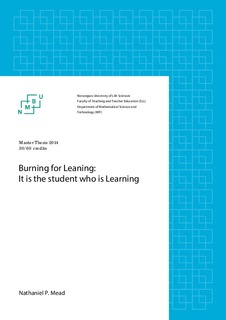| dc.contributor.author | Mead, Nathaniel P. | |
| dc.date.accessioned | 2014-09-17T11:21:06Z | |
| dc.date.available | 2014-09-17T11:21:06Z | |
| dc.date.copyright | 2014 | |
| dc.date.issued | 2014-09-17 | |
| dc.identifier.uri | http://hdl.handle.net/11250/220245 | |
| dc.description.abstract | This thesis documents how, through action research, I have explored methods and theories for improving my own educational practices in cooperation with students attending Sogn Jord- og Hagebruksskule (Norway´s national school for ecological agriculture). One motivating factor for this research was to find ways in which I could make changes or betterments in my own teaching tactics in the direction of using practice situations in farming, gardening and ‘green-care’ farming as learning landscapes for realizing competency criteria in the curriculum. Another related motivating factor was to help students to identify their interests, abilities and goals toward further development and mastery in this vocation. In having them go through this metacognitive process, besides being helpful for their own identity, the idea was that it would help me know better how to guide them further on their path.
This formal study has lasted since September 2012. The research question evolved from, in the beginning, having a focus on building bridges between school-based and farm-based training, to the final thesis question as to how to build bridges between educator and student and their search for learning. Case study was used to trial experiential learning theories in didactics as well as theory in relationship building between student and teacher. To enable us to experience a progression in learning the case study comprised of two repeating practice sessions with the same students on the same farm providing education for children with special needs. Methods for gathering empirical evidence were subjective survey, participatory observation, interviews assisted by questionnaires, conversations and student journal notations.
This thesis is comprised of seven parts. In part 1 the introduction includes a biographical discussion of what has led me towards a final formulation of the thesis question. Part 2 explores theoretical considerations regarding the research followed by Parts 3 and 4 with a discussion of research strategy and methods. Parts 5 and 6 present the case study and reflections. The seventh part is devoted to concluding remarks. | nb_NO |
| dc.language.iso | eng | nb_NO |
| dc.publisher | Norwegian University of Life Sciences, Ås | |
| dc.rights | Attribution-NonCommercial-NoDerivs 3.0 Norway | * |
| dc.rights.uri | http://creativecommons.org/licenses/by-nc-nd/3.0/no/ | * |
| dc.subject | Agriculture Educational and Didactics | nb_NO |
| dc.title | Burning for Learning : it is the student who is learning | nb_NO |
| dc.type | Master thesis | nb_NO |
| dc.subject.nsi | VDP::Social science: 200::Education: 280 | nb_NO |
| dc.subject.nsi | VDP::Agriculture and fishery disciplines: 900::Agriculture disciplines: 910 | nb_NO |
| dc.source.pagenumber | 124 | nb_NO |
| dc.description.localcode | M-LUN | nb_NO |

